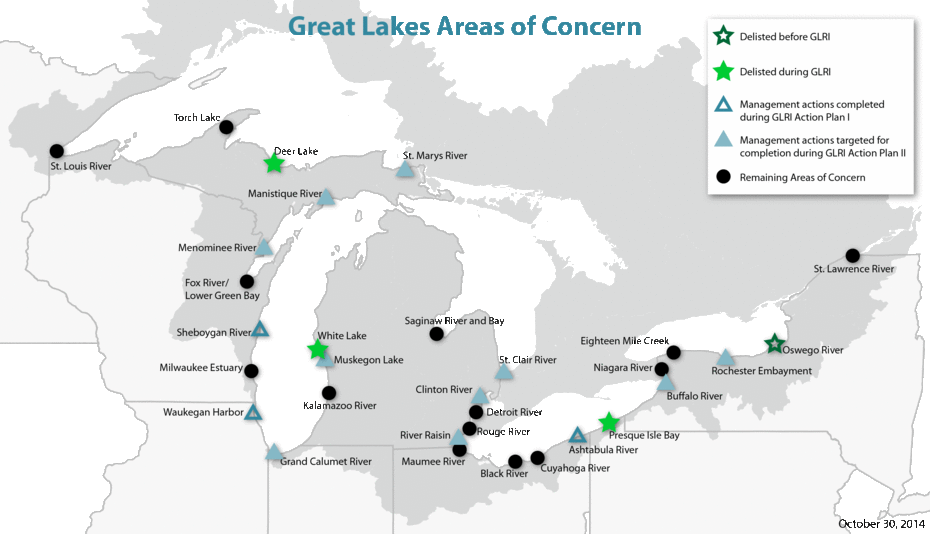For more than a century, the Great Lakes region has been at the heart of our country’s industrial engine. Steel mills, saw mills, foundries, and automotive production facilities have flourished there. “They got us through two world wars and made the country the world leader in the automotive sector,” says Cameron Davis, senior adviser to the Environmental Protection Agency administrator.
As time would tell, however, that industrial boon came at a price, one that affected the health of the lakes and the people living around them. Pollution marred these huge bodies of freshwater. In some places, PCBs and mercury smeared the lakes’ bottoms. In others, cadmium and nickel seeped into the sediment. Many toxic areas festered for years, contaminating fish, ruining habitat, and destroying local economies.
In 1987, the United States Congress and the Canadian government identified 43 of these industrial waste zones, deeming them “areas of concern,” a designation that targeted them for future clean up. Twenty-six AOCs were located in the U.S., 12 in Canada, and five on the shared border, with shared responsibility. It was a good start, but, as it turned out, eliminating all that pollution would require a lot of time, money, and effort on the part of local groups, states, and federal entities like the EPA. Without an influx of funds, many AOCs languished. Between 1987 and 2010, the EPA was able to delete just one from the list.

That changed in 2010 when President Obama created the Great Lakes Restoration Initiative, which allocated $700 million to the country’s remaining AOCs. Over the past six years, the initiative has allowed the government to, in Davis’ words, “punch the accelerator” on clean up. And lakefront communities are starting to see the results.
Take Muskegon Lake. Connected to Lake Michigan by a river, this area of concern once served as the dumping grounds for petrochemical companies and pulp and paper mills. The government dredged more than 43,000 cubic yards of sediment to reduce the amount of PCBs ingested by fish and the people who caught and ate those fish. The result? The PCB levels found in the lake’s fish are now about the same as those in fish caught in a contaminant-free lake nearby, and restrictions on eating Muskegon Lake fish have been lifted. Meanwhile, researchers monitoring the lake’s water quality have found that its levels of phosphorus—a nutrient that contributes to harmful algae blooms—are falling. Turtles and birds are returning as the lake’s shorelines are converted from concrete, riprap, and seawalls to a more natural state. The hope is that the government will be able to delist the site in the next few years, and there’s a good chance it will: Similar projects were used to restore White Lake, also connected to Lake Michigan, and that once-toxic hot spot was delisted in 2014.
Since the Great Lakes Restoration Initiative began, four sites have earned a delisting, and three more are on their way to doing the same. The government has put a plan in place to remediate those areas, and now state and local groups will monitor the AOCs to make sure the clean-up efforts are working. “It’s a little bit like having a patient on the operating table,” Davis says.
The Great Lakes will have fewer blemishes if the clean-up effort continues at its current pace, says Dave Allen, a professor at the University of Michigan’s School of Natural Resources and the Environment. Allen is also a member of the Great Lakes Advisory Board, which advises the EPA. “I have a ringside seat, and I would say they’re spending their money well,” he says. “They’re making progress in significant ways.”
Of course, this progress won’t happen overnight. The clean up of many AOCs is slow going due to their size and the amount of pollution plaguing them, and remediation is expected to continue through 2020. But it will be worth it. By some estimates, every dollar invested in restoration generates at least twice that much in return, thanks in part to boosts in tourism, says Ed Wolking, director of the Great Lakes Metro Chambers Coalition.
More important, the Great Lakes hold more than 20 percent of the world’s freshwater. “If you’re going to have a quality environment, you have to clean up these areas,” Wolking says. Lifting the stain of industry off these crucial bodies of water is simply the right thing to do.

This story originally appeared on Earthwire as “Seeking a Clean Bill of Health” and is re-published here under a Creative Commons license.





